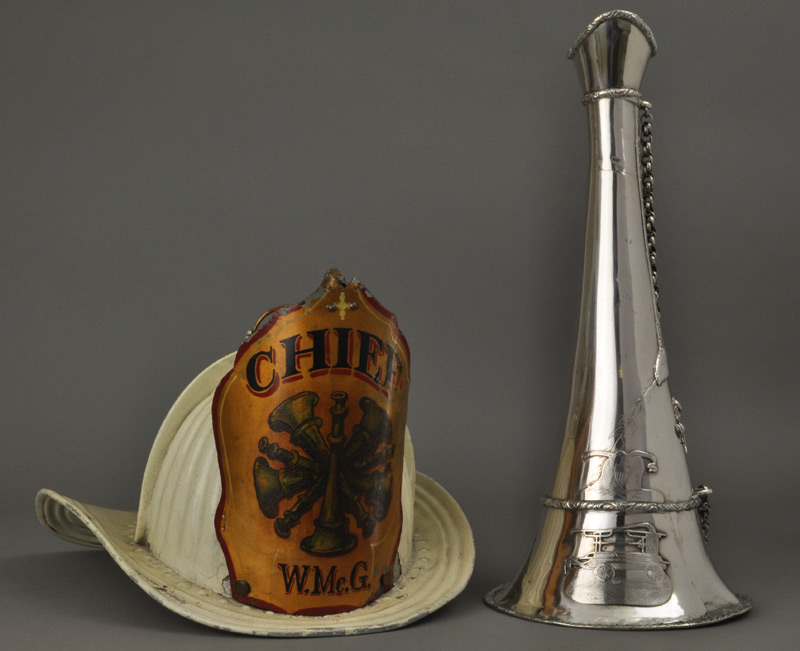Symbols of Authority and Gratitude
 The firefighter’s speaking trumpet, commonly called, simply, a bugle, is an important symbol of authority within the profession, and for good reason. Among the chaos of smoke and flame, coordination becomes necessary for not only success in battling the blaze, but also survival. In the days before the modern amplified bullhorn, speaking trumpets were the best way for a chief to make his orders heard. As a result the bugle became a symbol of authority in the iconography of firefighters. Even today rank can often be determined by the number of bugles pictured on a firefighter’s helmet or elsewhere on his or her uniform. A captain might just sport a pair of bugles, while a Chief Engineer, such as the one who wore the early 20th century helmet pictured, would have a crest bearing five crossed bugles. Of course these early chiefs would cement their power with an actual bugle through which they’d command their firefighters. This could be a significant challenge, judging by a chapter in the early history of Detroit’s firefighters. In the early 19th century, fire companies, although generally created by Detroit’s common council, were staffed by volunteers, and operated independently. Rivalries, ranging from playful to outright hostile were widespread among these early companies. When a disgruntled ex-printer from Detroit Gazette drunkenly set fire to his former employer on April 26, 1830, three of these companies arrived at the scene. Chief Engineer Levi Cook was unable to rally the three companies into a concerted effort, and the Detroit Gazette consequently attacked the discipline of the firefighters, resulting in a Common Council arranging a special experiment in cooperation for the three companies the following day. This is of course not to imply that the volunteer fire companies of these early days were ineffectual, as a beautiful silver bugle in our collection attests. Around 1 AM on April 16, 1849, a watchman in Detroit sounded an alarm in response to a warehouse fire across the river, in Windsor. Coupled with powerful chilling winds, the flames threatened to destroy the neighboring city. Under the command of Chief Engineer William Duncan, several companies gathered at the waterfront and awaited steamers to arrive which would list and nearly capsize into the freezing river as they cautiously ferried the firefighters and their bulky engines across. Thanks to the combined effort of the firefighters of both cities, the blaze was brought under control by 5 AM, and damage was confined to an acre. To express their gratitude, the people of Windsor presented Duncan with a silver bugle engraved with an inscription praising the Detroit firefighters for their “noble and generous conduct,” alongside an image of a hand-pumped fire engine, and symbols representing both the United States, and the British Empire.
The firefighter’s speaking trumpet, commonly called, simply, a bugle, is an important symbol of authority within the profession, and for good reason. Among the chaos of smoke and flame, coordination becomes necessary for not only success in battling the blaze, but also survival. In the days before the modern amplified bullhorn, speaking trumpets were the best way for a chief to make his orders heard. As a result the bugle became a symbol of authority in the iconography of firefighters. Even today rank can often be determined by the number of bugles pictured on a firefighter’s helmet or elsewhere on his or her uniform. A captain might just sport a pair of bugles, while a Chief Engineer, such as the one who wore the early 20th century helmet pictured, would have a crest bearing five crossed bugles. Of course these early chiefs would cement their power with an actual bugle through which they’d command their firefighters. This could be a significant challenge, judging by a chapter in the early history of Detroit’s firefighters. In the early 19th century, fire companies, although generally created by Detroit’s common council, were staffed by volunteers, and operated independently. Rivalries, ranging from playful to outright hostile were widespread among these early companies. When a disgruntled ex-printer from Detroit Gazette drunkenly set fire to his former employer on April 26, 1830, three of these companies arrived at the scene. Chief Engineer Levi Cook was unable to rally the three companies into a concerted effort, and the Detroit Gazette consequently attacked the discipline of the firefighters, resulting in a Common Council arranging a special experiment in cooperation for the three companies the following day. This is of course not to imply that the volunteer fire companies of these early days were ineffectual, as a beautiful silver bugle in our collection attests. Around 1 AM on April 16, 1849, a watchman in Detroit sounded an alarm in response to a warehouse fire across the river, in Windsor. Coupled with powerful chilling winds, the flames threatened to destroy the neighboring city. Under the command of Chief Engineer William Duncan, several companies gathered at the waterfront and awaited steamers to arrive which would list and nearly capsize into the freezing river as they cautiously ferried the firefighters and their bulky engines across. Thanks to the combined effort of the firefighters of both cities, the blaze was brought under control by 5 AM, and damage was confined to an acre. To express their gratitude, the people of Windsor presented Duncan with a silver bugle engraved with an inscription praising the Detroit firefighters for their “noble and generous conduct,” alongside an image of a hand-pumped fire engine, and symbols representing both the United States, and the British Empire.

